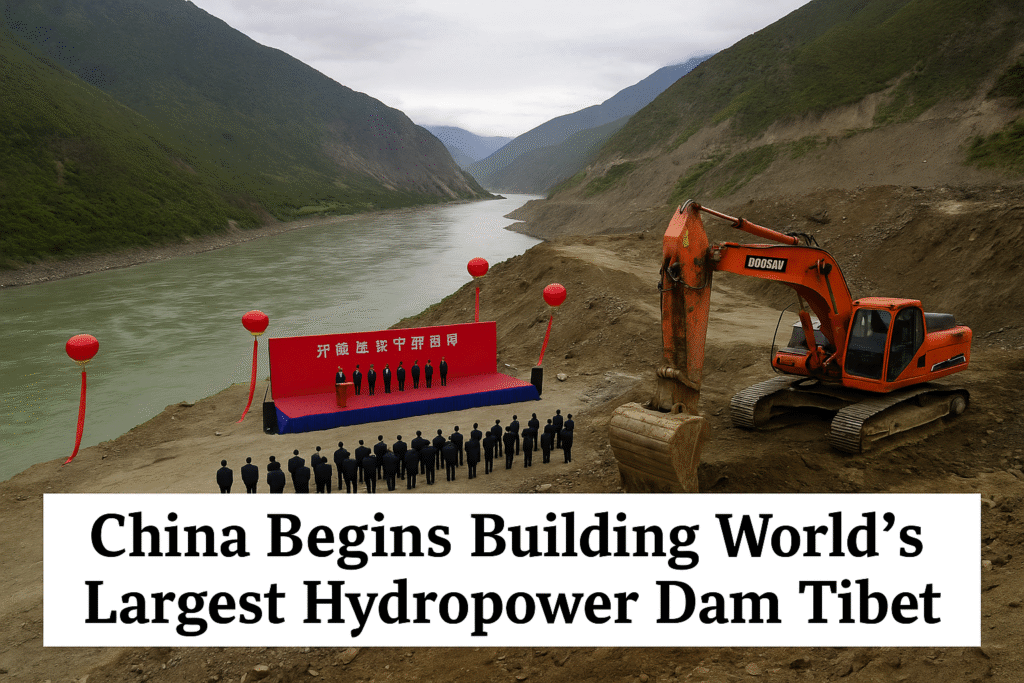Date Published: July 21, 2025
China has officially launched the construction of what is expected to become the world’s largest hydropower dam, deep within the Tibetan Autonomous Region, triggering environmental and geopolitical concerns from neighboring countries, especially India and Bangladesh.
🚧 Mega Project Begins on the Yarlung Tsangpo River
On Saturday, Chinese Premier Li Qiang led a groundbreaking ceremony that marked the beginning of this ambitious infrastructure initiative on the Yarlung Tsangpo River—a river that later becomes the Brahmaputra as it enters India and then flows into Bangladesh.
This location on the Tibetan plateau makes the project not just an engineering marvel but also a sensitive geopolitical issue due to the river’s downstream impact.
💰 Project Scale and Investment
According to Chinese state media, the mega-dam is set to cost a staggering 1.2 trillion yuan (approximately $167 billion USD or £125 billion GBP). If completed as planned, it would surpass all previous global hydropower projects in terms of capacity and scale.
Beijing claims that the construction is focused on:
- ✅ Renewable energy generation
- 🌱 Ecological conservation
- 🌍 Regional economic upliftment
🌊 Concerns From India and Bangladesh
While China maintains the project is environmentally conscious and locally beneficial, India and Bangladesh have voiced serious concerns over potential water shortages, environmental degradation, and threats to agricultural livelihoods downstream.
Key Concerns:
- 📉 Reduced water flow into downstream regions during dry seasons
- 🐟 Impact on aquatic ecosystems and fish populations
- 🌾 Disruption to farming communities in Assam (India) and northwestern Bangladesh
- 🚧 Lack of transparency and no multilateral water-sharing agreement
🏞 Environmental and Cultural Impact on Tibet
Environmentalists and Tibetan rights advocates argue the dam could severely affect the fragile Himalayan ecosystem and displace local communities. Critics also claim the project lacks sufficient local consultation and poses long-term risks to Tibet’s cultural heritage and biodiversity.
🌐 Strategic Implications Beyond Borders
This hydropower project is part of China’s broader strategy to become a global leader in clean energy, but it also underscores the increasing geopolitical tension over transboundary rivers in South Asia.
With India and China already locked in sensitive border disputes, this construction adds another layer of complexity to regional diplomacy.
📊 Summary Table: Key Facts About the Dam Project
| Aspect | Details |
|---|---|
| Project Name | Yarlung Tsangpo Hydropower Dam |
| Location | Tibetan Plateau, China |
| River Affected | Yarlung Tsangpo (Brahmaputra downstream) |
| Estimated Cost | 1.2 trillion yuan (~$167 billion USD) |
| Inauguration Ceremony | Led by Premier Li Qiang, July 2025 |
| Environmental Claims | Ecological protection and sustainable energy |
| Concerns Raised By | India, Bangladesh, Environmental NGOs |
🧭 Final Thoughts
China’s new hydropower endeavor in Tibet might mark a breakthrough in green energy—but it also reignites critical debates on water security, cross-border cooperation, and environmental ethics.
As the project moves forward, regional dialogue and transparent collaboration will be key to avoiding future water conflicts and protecting the interests of millions who depend on the Brahmaputra River downstream.
🔍 Keywords (SEO Optimized):
China Hydropower Project, Tibet Dam Construction, Yarlung Tsangpo River, World’s Largest Dam, Brahmaputra River Tensions, India China Water Conflict, Bangladesh Water Security, Hydroelectric Power in Tibet, South Asia Water Politics, Li Qiang Dam Ceremony
